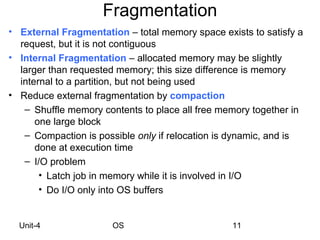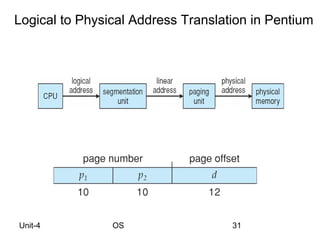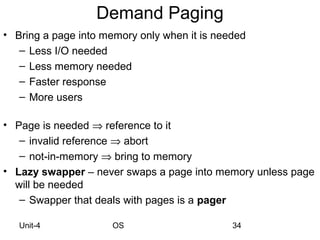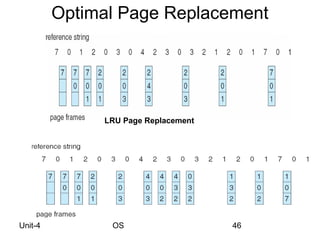Os Swapping, Paging, Segmentation and Virtual Memory
- 1. Lecture Plan UNIT-IV Lecture Topic Slide No. No. 1 Swapping 2-7 2 contiguous memory allocation 8-12 3 Paging 13-18 4 structure of the page table 19-29 5 Segmentation 30-42 6 page replacement 43-51 7 case studies UNIX, Linux, Windows 52 8 REVISION Unit-4 OS 1
- 2. Swapping • A process can be swapped temporarily out of memory to a backing store, and then brought back into memory for continued execution • Backing store – fast disk large enough to accommodate copies of all memory images for all users; must provide direct access to these memory images • Roll out, roll in – swapping variant used for priority- based scheduling algorithms; lower-priority process is swapped out so higher-priority process can be loaded and executed • Major part of swap time is transfer time; total transfer time is directly proportional to the amount of memory Unit-4 OS 2 swapped
- 3. Schematic View of Swapping Unit-4 OS 3
- 4. Base and Limit Registers • A pair of base and limit registers define the logical address space Unit-4 OS 4
- 5. Multistep Processing of a User Program Unit-4 OS 5
- 6. Memory-Management Unit (MMU) • Hardware device that maps virtual to physical address • In MMU scheme, the value in the relocation register is added to every address generated by a user process at the time it is sent to memory • The user program deals with logical addresses; it never sees the real physical addresses OS Unit-4 6
- 7. Dynamic relocation using a relocation register Unit-4 OS 7
- 8. Contiguous Allocation • Main memory usually into two partitions: – Resident operating system, usually held in low memory with interrupt vector • User processes then held in high memory Relocation registers used to protect user processes from each other, and from changing operating-system code and data – Base register contains value of smallest physical address – Limit register contains range of logical addresses – each logical address must be less than the limit register – MMU maps logical address dynamically Unit-4 OS 8
- 9. Hardware Support for Relocation and Limit Registers Unit-4 OS 9
- 10. Contiguous Allocation • Multiple-partition allocation – Hole – block of available memory; holes of various size are scattered throughout memory – When a process arrives, it is allocated memory from a hole large enough to accommodate it – Operating system maintains information about: a) allocated partitions b) free partitions (hole) OS OS OS OS process 5 process 5 process 5 process 5 process 9 process 9 process 8 process 10 process 2 process 2 process 2 process 2 Unit-4 OS 10
- 11. Fragmentation • External Fragmentation – total memory space exists to satisfy a request, but it is not contiguous • Internal Fragmentation – allocated memory may be slightly larger than requested memory; this size difference is memory internal to a partition, but not being used • Reduce external fragmentation by compaction – Shuffle memory contents to place all free memory together in one large block – Compaction is possible only if relocation is dynamic, and is done at execution time – I/O problem • Latch job in memory while it is involved in I/O • Do I/O only into OS buffers Unit-4 OS 11
- 12. Paging • Logical address space of a process can be noncontiguous; process is allocated physical memory whenever the latter is available • Divide physical memory into fixed-sized blocks called frames (size is power of 2, between 512 bytes and 8,192 bytes) • Divide logical memory into blocks of same size called pages • Keep track of all free frames • To run a program of size n pages, need to find n free frames and load program • Set up a page table to translate logical to physical addresses • Internal fragmentation Unit-4 OS 12
- 13. Address Translation Scheme • Address generated by CPU is divided into: – Page number (p) – used as an index into a page table which contains base address of each page in physical memory – Page offset (d) – combined with base address to define the physical memory address that is sent to the memory unit page number page offset p d m-n n – For given logical address space 2m and page size 2n Unit-4 OS 13
- 14. Paging Hardware Unit-4 OS 14
- 15. Paging Model of Logical and Physical Memory Unit-4 OS 15
- 16. Paging Example 32-byte memory and 4-byte pages Unit-4 OS 16
- 17. Free Frames Before allocation After allocation Unit-4 OS 17
- 18. Implementation of Page Table • Page table is kept in main memory • Page-table base register (PTBR) points to the page table • Page-table length register (PRLR) indicates size of the page table • In this scheme every data/instruction access requires two memory accesses. One for the page table and one for the data/instruction. • The two memory access problem can be solved by the use of a special fast-lookup hardware cache called associative memory or translation look-aside buffers (TLBs) • Some TLBs store address-space identifiers (ASIDs) in each TLB entry – uniquely identifies each process to provide address-space protection for that process Unit-4 OS 18
- 19. Paging Hardware With TLB Unit-4 OS 19
- 20. Shared Pages • Shared code – One copy of read-only (reentrant) code shared among processes (i.e., text editors, compilers, window systems). – Shared code must appear in same location in the logical address space of all processes • Private code and data – Each process keeps a separate copy of the code and data – The pages for the private code and data can appear anywhere in the logical address space Unit-4 OS 20
- 21. Shared Pages Example Unit-4 OS 21
- 22. Two-Level Page-Table Scheme Unit-4 OS 22
- 23. Two-Level Paging Example • A logical address (on 32-bit machine with 1K page size) is divided into: – a page number consisting of 22 bits – a page offset consisting of 10 bits • Since the page table is paged, the page number is further divided into: – a 12-bit page number – a 10-bit page offset • Thus, a logical address is as follows: where pi is an index into the outer page table, and p2 is the displacement within the page of the outer page table page page offset number p pi 2 d 12 10 10 Unit-4 OS 23
- 24. Address-Translation Scheme Unit-4 OS 24
- 25. Three-level Paging Scheme Unit-4 OS 25
- 26. Hashed Page Tables • Common in address spaces > 32 bits The virtual page number is hashed into a page table – This page table contains a chain of elements hashing to the same location Virtual page numbers are compared in this chain searching for a match – If a match is found, the corresponding physical frame is extracted Unit-4 OS 26
- 27. Inverted Page Table • One entry for each real page of memory • Entry consists of the virtual address of the page stored in that real memory location, with information about the process that owns that page • Decreases memory needed to store each page table, but increases time needed to search the table when a page reference occurs • Use hash table to limit the search to one — or at most a few — page- table entries Unit-4 OS 27
- 28. Segmentation • Memory-management scheme that supports user view of memory • A program is a collection of segments – A segment is a logical unit such as: main program procedure function method object local variables, global variables common block stack symbol table Unit-4 arrays OS 28
- 29. Segmentation Architecture • Logical address consists of a two tuple: <segment-number, offset>, • Segment table – maps two-dimensional physical addresses; each table entry has: – base – contains the starting physical address where the segments reside in memory – limit – specifies the length of the segment • Segment-table base register (STBR) points to the segment table’s location in memory • Segment-table length register (STLR) indicates number of segments used by a program; Unit-4 segment number s is legal29 s < STLR OS if
- 30. Segmentation Hardware Unit-4 OS 30
- 31. Logical to Physical Address Translation in Pentium Unit-4 OS 31
- 32. Pentium Paging Architecture Unit-4 OS 32
- 33. Three-level Paging in Linux Unit-4 OS 33
- 34. Demand Paging • Bring a page into memory only when it is needed – Less I/O needed – Less memory needed – Faster response – More users • Page is needed ⇒ reference to it – invalid reference ⇒ abort – not-in-memory ⇒ bring to memory • Lazy swapper – never swaps a page into memory unless page will be needed – Swapper that deals with pages is a pager Unit-4 OS 34
- 35. Page Fault • If there is a reference to a page, first reference to that page will trap to operating system: page fault 1. Operating system looks at another table to decide: – Invalid reference ⇒ abort – Just not in memory 2. Get empty frame 3. Swap page into frame 4. Reset tables 5. Set validation bit = v 6. Restart the instruction that caused the page fault Unit-4 OS 35
- 36. Steps in Handling a Page Fault Unit-4 OS 36
- 37. Performance of Demand Paging • Page Fault Rate 0 ≤ p ≤ 1.0 – if p = 0 no page faults – if p = 1, every reference is a fault • Effective Access Time (EAT) EAT = (1 – p) x memory access + p (page fault overhead + swap page out + swap page in + restart overhead Unit-4 OS 37
- 38. Copy-on-Write • Copy-on-Write (COW) allows both parent and child processes to initially share the same pages in memory If either process modifies a shared page, only then is the page copied • COW allows more efficient process creation as only modified pages are copied • Free pages are allocated from a pool of zeroed- Unit-4 pages out OS 38
- 39. Before Process 1 Modifies Page C Unit-4 OS 39
- 40. After Process 1 Modifies Page C Unit-4 OS 40
- 41. Page Replacement • Prevent over-allocation of memory by modifying page- fault service routine to include page replacement • Use modify (dirty) bit to reduce overhead of page transfers – only modified pages are written to disk • Page replacement completes separation between logical memory and physical memory – large virtual memory can be provided on a smaller physical memory Unit-4 OS 41
- 42. Need For Page Replacement Unit-4 OS 42
- 43. Page Replacement Unit-4 OS 43
- 44. Graph of Page Faults Versus The Number of Frames Unit-4 OS 44
- 45. FIFO Page Replacement FIFO Illustrating Belady’s Anomaly Unit-4 OS 45
- 46. Optimal Page Replacement LRU Page Replacement Unit-4 OS 46
- 47. Use Of A Stack to Record The Most Recent Page References Unit-4 OS 47
- 48. Second-Chance (clock) Page-Replacement Algorithm Unit-4 OS 48
- 49. Counting Algorithms • Keep a counter of the number of references that have been made to each page LFU Algorithm: replaces page with smallest count MFU Algorithm: based on the argument that the page with the smallest count was probably just brought in and has yet to be used Unit-4 OS 49
- 50. Windows XP • Uses demand paging with clustering. Clustering brings in pages surrounding the faulting page • Processes are assigned working set minimum and working set maximum • Working set minimum is the minimum number of pages the process is guaranteed to have in memory • A process may be assigned as many pages up to its working set maximum • When the amount of free memory in the system falls below a threshold, automatic working set trimming is performed to restore the amount of free memory • Working set trimming removes pages from processes that have pages in excess of their working set minimum Unit-4 OS 50
- 51. Solaris • Maintains a list of free pages to assign faulting processes • Lotsfree – threshold parameter (amount of free memory) to begin paging • Desfree – threshold parameter to increasing paging • Minfree – threshold parameter to being swapping • Paging is performed by pageout process • Pageout scans pages using modified clock algorithm • Scanrate is the rate at which pages are scanned. This ranges from slowscan to fastscan • Pageout is called more frequently depending upon the amount of free memory available Unit-4 OS 51
- 52. Solaris 2 Page Scanner Unit-4 OS 52



















































